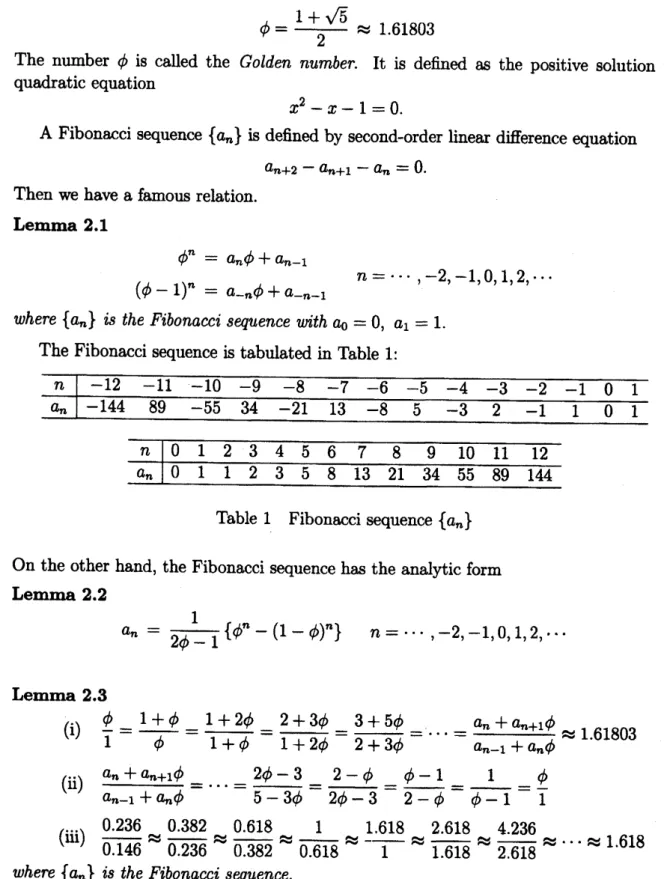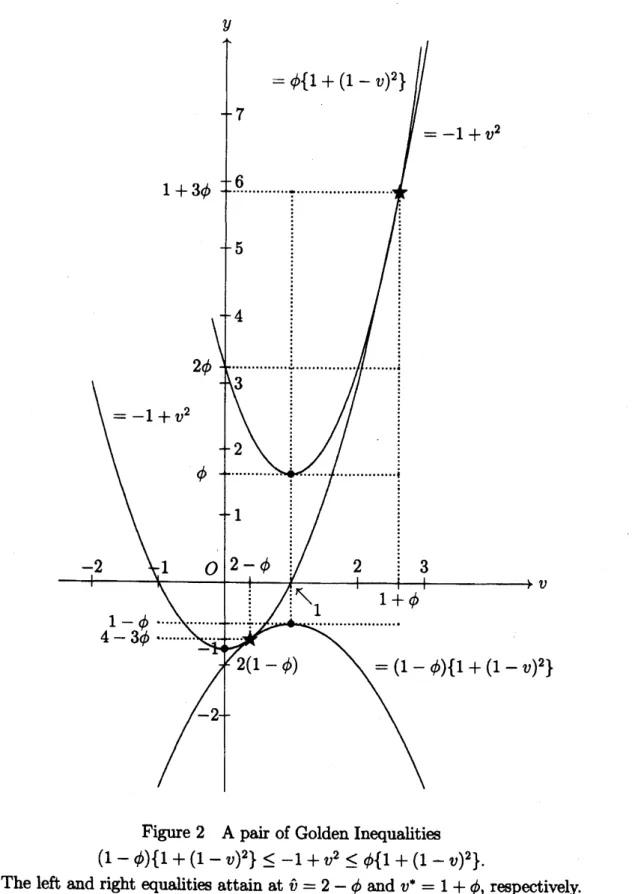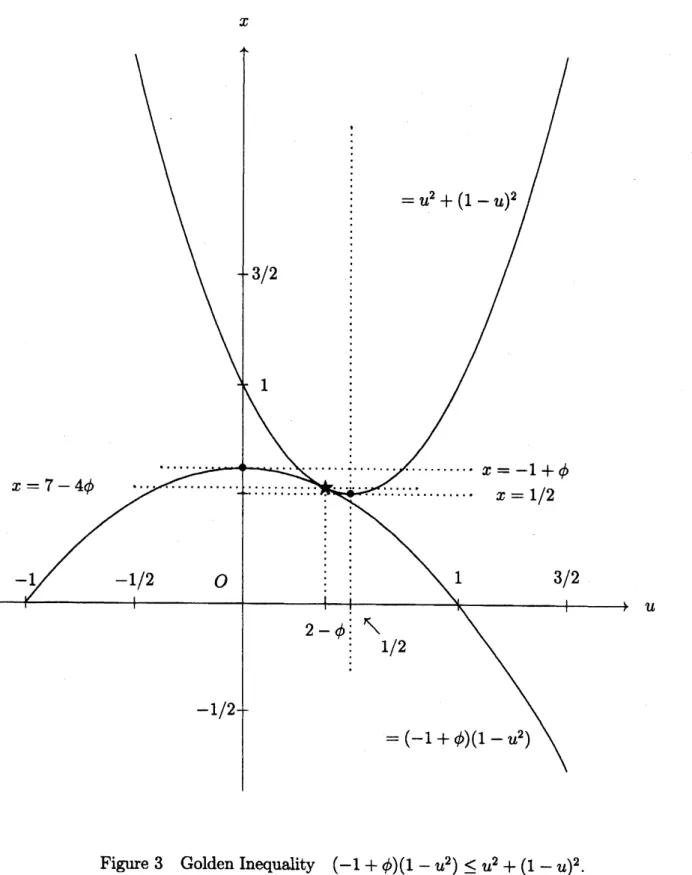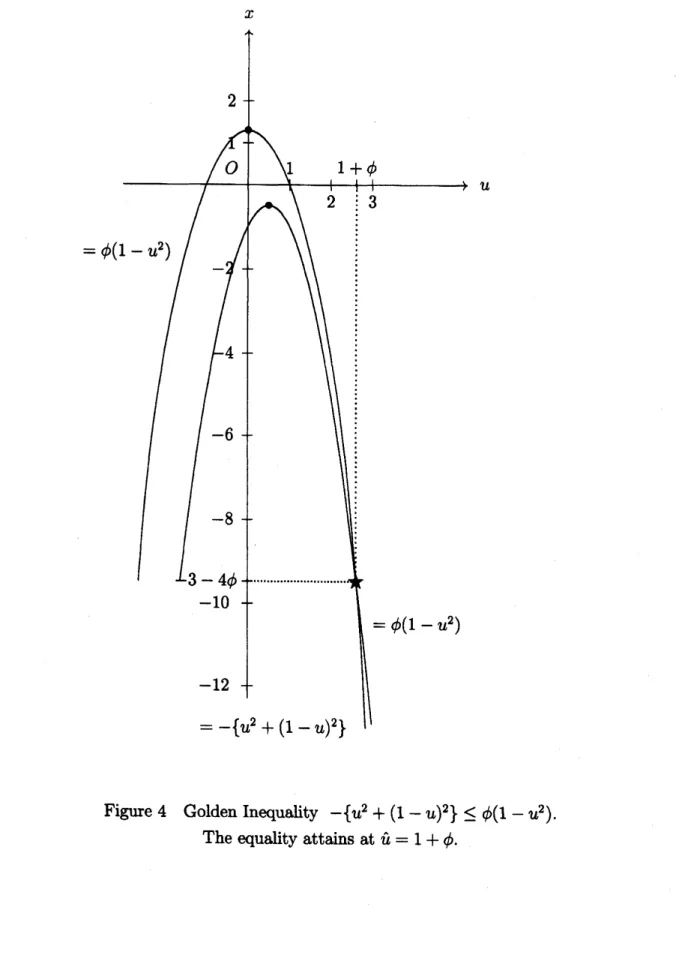On
Golden
inequalities
Seiichi
IWAMOTO
and
Akifumi
KIRA
Department
of Economic Engineering
Graduate School
of Economics,
Kyushu
University
Fukuoka 812-8581,
Japan
tel&fax. +81(92)642-2488, email: iwamoto@en.kyushu-u.ac.jp
Abstract
We consideraninequality with equality condition whereonesideisgreater (resp.
less) than orequalto amultiple of the other side and an equality holds if and only
ifone value is amultiple of the other variable. When the two multiples constitute
a Golden ratio, the inequality is called Golden. This paper presents six Golden
inequalities both among one-variable functions and among two-variable functions.
We show across-duality between four pairs ofGolden inequalities for one-variable
functions. Similar results for twovariable functions are stated. Further a graphic
representation for Golden inequalities is shown.
1
Introduction
Both historically and practically, it is well known that the
Golden
raio has been takingan
interestingpart inmany
fields in science, technology, art, architecture, biology andso
on $[3, 13]$
.
In mathematical science, the Goldenratio has recently been incorporated intooptimization field [8-10, 12]. This paper is motivated by trying to introduce and discuss
the Golden ratio in the fields of inequalities [1,2,4-7,11]. In fact, there exists
a
mutualrelationshipbetween optimizaion and inequality [1,2,4,5,7,10].
In this paper
we
considera
class ofGolden
inequalitiesbetween
two givenfunctions.
A pair of two real values is called Golden ifit
constitutes the Golden
ratio.We
consideran
inequality ofthe following form.One
side consists ofone
functiononly. The otherside consists ofa multipleofthe otherfunction.
One side is greater (resp. less) thanor
equalto the other side. Further the sign ofequality holds ifand only if
one
value isa
multipleofthe other value. Ifthe pair oftwo multiples is Golden, theinequality is called Golden.
We present six Golden inequalities for one-variable quadratic
functions.
We showa
cross-duality between fourpairsofGoldeninequalities for one-variable functions. Similar
results for two-variable quadratic functions
are
stated. Further a graphic representation2
The
Golden Ratio
We take
a
basic standardreal number$\phi=\frac{1+\sqrt{5}}{2}\approx$
1.61803
The number $\phi$ is called the Golden number. It is defined
as
the positive solution to
quadratic equation
$x^{2}-x-1=0$.
A
Fibonacci sequence
$\{a_{n}\}$ isdefined
by second-order lineardifference
equation$a_{n+2}-a_{n+1}-a_{n}=0$.
Then
we
havea
famous
relation.Lemma
2.1$\phi^{n}=a_{n}\phi+a_{n-1}$
$(\phi-1)^{n}=a_{-n}\phi+a_{-n-1}$ $n=\cdots,$
$-2,$$-1,0,1,2,$$\cdots$
where
$\{a_{n}\}$ is theFibonacci sequence
urith $a_{0}=0,$ $a_{1}=1$.The Fibonacci sequence
istabulated
in Table 1:Table 1 Fibonacci sequence $\{a_{n}\}$
On the other hand, the
Fibonacci
sequence has the analyticform
Lemma 2.2
$a_{n}= \frac{1}{2\phi-1}\{\phi^{n}-(1-\phi)^{n}\}$
Lemma 2.3
$n=\cdots,$ $-2,$$-1,0,1,2,$$\cdots$
(i) $\frac{\phi}{1}=\frac{1+\emptyset}{\phi}=\frac{1+2\phi}{1+\emptyset}=\frac{2+3\phi}{1+2\emptyset}=\frac{3+5\phi}{2+3\phi}=\cdots=\frac{a_{n}+a_{n+1}\phi}{a_{n-1}+a_{n}\phi}\approx 1.61803$
(\"u) $\frac{a_{\mathrm{n}}+a_{n+1}\phi}{a_{n-1}+a_{n}\phi}=\cdots=\frac{2\phi-3}{5-3\phi}=\frac{2-\emptyset}{2\phi-3}=\frac{\phi 1}{2\phi}==\frac{1}{\phi-1}=\frac{\phi}{1}$
(\"ui) $\frac{0236}{0146}:\approx:\frac{0382}{0236}\approx:\frac{0618}{0382}\approx\frac{1}{0.618}\approx\frac{1.618}{1}\approx:\frac{2618}{1618}\approx:\frac{4236}{2618}\approx\cdots\approx 1.618$
3
One-variable
Functions
Let
us
consideran
inequality betweentwo
one-variablefunctions
$f,$ $g:R^{1}arrow R^{1}$ withan
equality condition. Weassume
that inequality$f(u)\leq(\geq)\alpha g(u)$
on
$R^{1}$ (1)holds.
The
signof
equality holds if and only if$u=\beta$,
where$\alpha$ and $\beta$are
realconstants.
Definition
3.1 Wesay
that thepair $(\alpha, \beta)$ constitutes theGolden
ratioif
$| \frac{\beta}{\alpha}|=\emptyset$
or
$| \frac{\alpha}{\beta}|=\emptyset$.Deflnition 3.2
When the pair constitutes theGolden
ratio, the inequality (1) is calledGolden.
For
instance we
see
that inequality$1+u^{2}\leq(1+\phi)\{1+(u-1)^{2}\}$
on
$R^{1}$ (2)holds. The sign ofequality holds ifand only if$u=\emptyset$
.
Further $(\phi, 1+\emptyset)$ constitutes theGoldenratio. Thus (2) is
a
Golden inequality.First
we
consider six Golden inequalitiesbetween
one-variable quadraticfunctions.
The
inequalities (3) and (4)are
pairs ofGolden
inequalities. The inequalities (5) and (6)are Golden.
Thuswe
havesix Golden inequahities in thefollowing.
Lemma 3.1 (i) It holds that
$(2-\phi)\{1+(u-1)^{2}\}\leq 1+u^{2}\leq(1+\phi)\{1+(u-1)^{2}\}$
on
$R^{1}$. (3)The sign
of
left
equalityholdsif
and onlyif
$u=1-\emptyset$ and the signof
right equality holdsif
and onlyif
$u=\phi([\mathit{8}-\mathit{1}\mathit{0}J)$.
(ii) It holds that
$(1-\phi)\{1+(v-1)^{2}\}\leq-1+v^{2}\leq\phi\{1+(v-1)^{2}\}$
on
$R^{1}$.
(4)The sign
of left
equality holdsif
and onlyif
$v=2-\phi$ and the signof
right equalityholds
if
and
onlyif
$v=1+\phi$ (Figure 2).(iii) The middle-right inequality (resp. left-middle) in (3) is equivalentto the
left-middle
(resp. middle-right) inequality in (4).
Lemma
3.2 (i) It holds that$(-1+\phi)(1-u^{2})\leq u^{2}+(u-1)^{2}$
on
$R^{1}$ (5)The sign
of
equality holdsif
and onlyif
$u=2-\emptyset$ (Figure 3).It holds that
$-u^{2}-(u-1)^{2}\leq\phi(1-u^{2})$
on
$R^{1}$(6)
The sign
of
equality holdsif
and onlyif
$u=1+\phi$ (Figure 4).(ii)
The
inequality (5) $\dot{w}$ equivalentto
themiddle-right
inequality in (4).The inequality
3.1
A
pair of
Golden
inequalities
between
$1+(1-v)^{2}\mathrm{a}\mathrm{n}\mathrm{d}-1+v^{2}$Figure 2 A pair of
Golden
Inequalities$(1-\phi)\{1+(1-v)^{2}\}\leq-1+v^{2}\leq\phi\{1+(1-v)^{2}\}$
.
3.2
One
Golden
inequality
between
$1-u^{2}$and
$u^{2}+(1-u)^{2}$$x$
$u$
Figure 3 GoldenInequality $(-1+\phi)(1-u^{2})\leq u^{2}+(1-u)^{2}$.
3.3
The other
Golden
inequality
between
$1-u^{2}$and
$u^{2}+(1-u)^{2}$ $.\tau$Figure 4 GoldenInequality $-\{u^{2}+(1-u)^{2}\}\leq\phi(1-u^{2})$
.
4
Two-variable ffinctions
Let
us
taketwo
two-variablefunctions
$f,$ $g:R^{2}arrow R^{1}$.
We
assume
that inequality$f(x,y)\leq(\geq)\alpha g(x,y)$
on
$R^{2}$(7)
holds and
that
the sign ofequality holds ifand only if$y=\beta x$.Deflnition
4.1 When the pair $(\alpha, \beta)$ constitutesthe Golden
ratio, theinequality (7) is
called
Golden.
For instance, the inquality
$x^{2}+y^{2}\geq(2-\phi)\{x^{2}+(y-x)^{2}\}$
on
$R^{2}$(8)
holds. The signof equality holds ifand only if$y=(1-\phi)x$
.
Thus inequality (8) is alsoGolden.
4.1
Cauchy-Schwarz
Let
us
take $f(x,y)=(ax+by)^{2},$ $g(x,y)=x^{2}+y^{2}$, where $a(\neq 0),$ $b$are
realconstants.
Then it holds that
$(ax+by)^{2}\leq(a^{2}+b^{2})(x^{2}+y^{2})$
on
$R^{2}$.
(9)
$\mathrm{W}\mathrm{h}\mathrm{e}\mathrm{n}\alpha=\frac{b\mathrm{e}}{\mathrm{o}1a}\mathrm{a}\mathrm{n}.\mathrm{d}\beta=a^{2}+b^{2}\mathrm{c}\mathrm{o}\mathrm{n}\mathrm{s}\mathrm{t}\mathrm{i}\mathrm{t}\mathrm{u}\mathrm{t}\mathrm{e}\mathrm{t}\mathrm{h}\mathrm{e}\mathrm{G}\mathrm{o}1\mathrm{d}\mathrm{b}\mathrm{e}\mathrm{c}\mathrm{o}\mathrm{m}\text{\’{e}} \mathrm{G}\mathrm{d}\mathrm{e}\mathrm{n}\mathrm{T}\mathrm{h}\mathrm{e}\mathrm{s}\mathrm{i}\mathrm{g}\mathrm{n}\mathrm{o}\mathrm{f}\mathrm{q}\mathrm{u}\mathrm{a}1\mathrm{i}\mathrm{t}\mathrm{y}\mathrm{h}\mathrm{o}1\mathrm{d}\mathrm{s}\mathrm{i}\mathrm{f}\mathrm{a}\mathrm{n}\mathrm{d}\mathrm{o}\mathrm{n}1\mathrm{y}\mathrm{i}\mathrm{f}ay=bx$
en
ratio, theCauchy-Schwart inequality4.2
Golden
inequalities
Wespecifysix Goldeninequalitiesbetween two-variablequadratic
functions.
Eachof (10)and (11) yields
a
pair ofGoldeninequalities. Both (12) and (13)are
Golden
inequalities.Thus
we
have also sixGolden
inequalities in the following.Theorem 4.1 (i) It holds that
$(2-\phi)\{x^{2}+(y-x)^{2}\}\leq x^{2}+y^{2}\leq(1+\phi)\{x^{2}+(y-x)^{2}\}$
on
$R^{2}$. (10)The sign
of
left
equality holdsif
and onlyif
$y=(1-\phi)x$ and the signof
right equalityholds
if
and onlyif
$y=\phi x$.
(ii) It
holds
that$(1-\phi)\{x^{2}+(y-x)^{2}\}\leq-x^{2}+y^{2}\leq\phi\{x^{2}+(y-x)^{2}\}$
on
$R^{2}$.
(11)The sign
of lefl
equality holdsif
and onlyif
$y=(2-\phi)x$ and the signof
right equalityhol& $if$ and only
if
$y=(1+\phi)x$.
(iii) The middle-right inequality (resp. left-middle) in(10) is equivalentto the
left-middle
(resp. middle-ri9ht) inequality in (11).Theorem 4.2 (i) It holds that
$(-1+\phi)(x^{2}-y^{2})\leq y^{2}+(y-x)^{2}$
on
$R^{2}$. (12)The sign
of left
equality holdsif
and onlyif
$y=(2-\phi)x$.
It holds that$-y^{2}-(y-x)^{2}\geq\phi(x^{2}-y^{2})$
on
$R^{2}$.
(13)The sign
of
right equality holdsif
and onlyif
$y=(1+\phi)x$.
(ii) Theinequality (12) is equivalentto the middle-right inequality in (11). The inequality (13) is equivalent
to
theleft-middle
inequality in (11).References
[1] E.F. Beckenbach and R.E. BeUman, Inequalities, Springer-Verlag, Ergebnisse 30,
1961.
[2] R.E. Bellman, Introduction to Matriv Analy8is, $\mathrm{M}\mathrm{c}\mathrm{G}\mathrm{r}\mathrm{a}\mathrm{w}$-Hill, New York, NY,
1970
(Second Edition is
a SIAM
edition 1997).[3] A. Beutekpacher and B. Petri, $\Leftrightarrow*j*\S\rfloor$
–eas
$k\mathfrak{B}\mathrm{E}\ _{\overline{\mathrm{R}}}^{-}\mathrm{f}\mathrm{f}\mathrm{l}\ -(\mathfrak{M}\#\mathrm{B}\mathfrak{F})$,
$\#\mathrm{E}$$\mathrm{f}\mathrm{f}\mathrm{l}\mathfrak{B}$, 2005; (Original) Der Goldene
Schnitt
2., \"uberarbeitete und erweitene Auflange,ELSEVIER
GmbH, SpectrumAkademischer
Verlag, Heidelberg,1996.
[4]
S.
Iwamoto,Inverse
theoremin dynamicprogramming I, II, III, J. Math. Anal. Appl. 58(1977), 113-134, 247-279,439-448.
[5] S. Iwamoto, Dynamic programming approach to inequalities, J. Math. Anal. Appl. 58(1977),
687-704.
[6] S. Iwamoto, Reverse function,
reverse
program andreverse
theorem in mathematical programming, J. Math. Anal. Appl. 95(1983), 1-19.[7] $\pi^{\mathrm{J}}\mathrm{B}\mu$
ru–,
r#\S
-$\varpi \mathrm{U}\epsilon*\Leftrightarrow \mathfrak{X}\}_{\mathrm{c}’}^{\vee}\supset \mathrm{v}\backslash \tau,$$\Re*k_{\mathrm{r}}^{<}\lceil\{T\mathrm{f}\mathrm{f}\mathrm{l}\mathfrak{F}_{\mathrm{r}\mathrm{W}}^{\mathfrak{B}}\ *\sigma)\ovalbox{\tt\small REJECT}_{\grave{\mathrm{J}}}H\mathrm{J}$
,
$\overline{R}\star\ \mathfrak{B}$ $\Re\not\in\Re 8653$, $1988*4$fl, pp.109-129.
[8]
S.
Iwamoto,\yen 4BEffi\emptyset ae\not\equiv A\star f,
$\Re\Re\#^{\underline{<}}\lceil\ovalbox{\tt\small REJECT}\#\emptyset\ovalbox{\tt\small REJECT} \mathrm{E}ffl\Re\rfloor$ ,$\overline{R}\star \mathrm{a}\mathrm{e}\not\in\Re\Re\Re 8$1443, $2005\not\in 7$fl, pp.
27-43.
[9]
S.
Iwamoto, TheGolden
optimumsolution inquadraticprogramming, Ed. W.Taka-hashi and T. Tanaka, Proceedings of The Fourth
International Conference
on
Non-$1_{\dot{\mathrm{i}}}$
ear
Analysis and ConvexAnalysis (NACA05), under submission.
[10] S. Iwamoto, The Golden trinity –optimility, inequality, identity –, $\lceil\Phi\#\emptyset\Re \mathfrak{B}$
[11]
S.
Iwamoto,R.J. Tomkins
and C.-L. Wang,Some
theorems
on
reverse
inequalities,J. Math.
Anal.
Appl. 119(1986),282-299.
[12]
S. Iwamoto
and M. Yasuda, “Dynamic programmingcreates the GoldenRatio, too,”Proc.
of
the Sixth IntlConference
on
Optimization: Techniques and Applications(ICOTA 2004), Ballarat, Australia, December 9-11,
2004.
[13] H. Walser, $\mathrm{g}*_{J}^{j}+\Leftrightarrow \mathrm{j}(\mathfrak{B}^{\grave{\backslash }}l\mathrm{I}\doteqdot \mathbb{R}\ovalbox{\tt\small REJECT})$ ,$\mathrm{B}\mathrm{X}^{-\Supset \mathrm{A}}--H_{\beta \mathrm{f}\mathrm{f}\mathrm{l}}\dagger\pm$, 2002; (Original) DER



